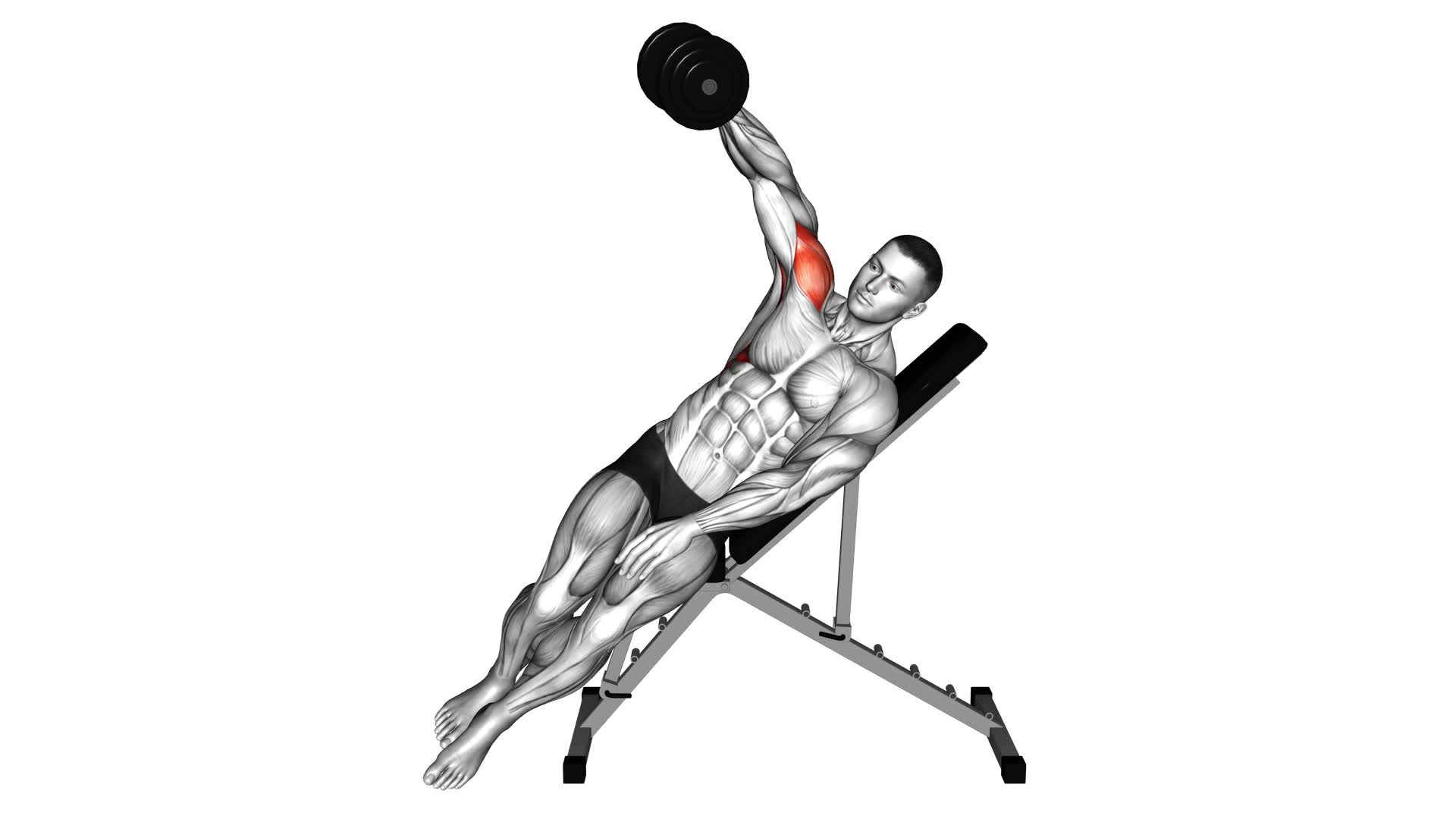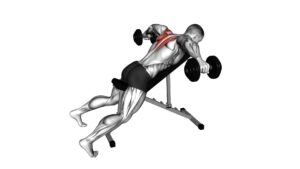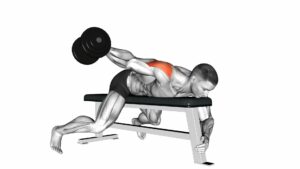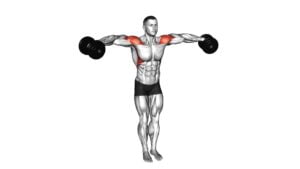Dumbbell Incline One Arm Lateral Raise – Video Exercise Guide & Tips

Are you looking to strengthen and tone your shoulder muscles?
Watch This Exercise Video
Then the dumbbell incline one arm lateral raise is the perfect exercise for you.
In this video exercise guide, we'll show you the proper form and technique to maximize your results.
Find out the benefits of this exercise and how to set up for success with the right equipment and positioning.
Avoid common mistakes and get tips for progression.
Let's get started for a stronger upper body!
Key Takeaways
- Upright posture and engaged core are crucial for proper form
- Proper form maximizes benefits and minimizes risk of injury
- Targets and strengthens lateral deltoid muscles
- Engages stabilizer muscles in core and upper back, improving stability and posture
Proper Form and Technique
To perform the Dumbbell Incline One Arm Lateral Raise exercise with proper form and technique, ensure your posture is upright and your core is engaged. Maintaining proper form is crucial as it not only maximizes the benefits of the exercise but also minimizes the risk of injury.
One of the benefits of using proper form is that it targets the specific muscles you're trying to work. By keeping your posture upright, you engage your shoulder muscles more effectively, specifically the lateral deltoids. This helps in developing overall shoulder strength and stability. Additionally, engaging your core muscles throughout the exercise helps in maintaining balance and stability, preventing any unnecessary strain on your lower back.
To ensure proper form, avoid common mistakes such as using momentum to lift the weight. Instead, focus on controlled movements, lifting the weight up and lowering it down in a slow and controlled manner. Another mistake to avoid is shrugging your shoulder or bending your torso sideways while lifting the weight. This not only reduces the effectiveness of the exercise but also puts unnecessary strain on your neck and lower back.
Benefits of the Dumbbell Incline One Arm Lateral Raise
Now let's explore the benefits of the Dumbbell Incline One Arm Lateral Raise.
This exercise primarily targets the lateral deltoid muscles, helping to sculpt and strengthen your shoulders.
Additionally, it engages the stabilizer muscles in your core and upper back, improving overall stability and posture.
Try different variations and progressions to challenge yourself and maximize the benefits of this exercise.
Muscle Activation Areas
Activate your deltoids and upper back muscles with the dumbbell incline one arm lateral raise. This exercise specifically targets and activates these muscle groups, helping to strengthen and tone them.
Here are three key benefits of the dumbbell incline one arm lateral raise:
- Increased shoulder stability: By engaging your deltoids, this exercise helps to improve stability in your shoulder joints, reducing the risk of injury during other upper body exercises.
- Improved posture: Strengthening your upper back muscles through this exercise can help improve your overall posture, reducing the likelihood of developing rounded shoulders or a hunched back.
- Enhanced shoulder aesthetics: The dumbbell incline one arm lateral raise helps to sculpt and define your deltoids, giving your shoulders a more toned and defined appearance.
Variations and Progressions
While performing the dumbbell incline one arm lateral raise, you can incorporate variations and progressions to further challenge your deltoids and upper back muscles. One variation you can try is the seated incline one arm lateral raise, which involves sitting on an incline bench instead of lying down. This variation targets the same muscles but from a different angle.
Another variation is the standing one arm lateral raise, where you perform the exercise while standing upright. This variation increases the stability challenge and engages your core muscles as well.
To progress the exercise, you can increase the weight of the dumbbell or perform more reps. You can also slow down the tempo of the movement, focusing on the eccentric phase to increase the intensity. By incorporating these variations and training techniques, you can continue to challenge and strengthen your deltoids and upper back muscles.
Now, let's move on to setting up for success: equipment and positioning.
Setting Up for Success: Equipment and Positioning
To set yourself up for success with the Dumbbell Incline One Arm Lateral Raise, it's important to focus on two key points: proper equipment selection and correct body positioning.
Choose dumbbells that challenge your muscles without compromising your form.
Position yourself on an incline bench with your feet firmly planted on the ground and your core engaged for stability.
Proper Equipment Selection
Choose the appropriate equipment to ensure proper positioning and set yourself up for success with the Dumbbell Incline One Arm Lateral Raise. Proper equipment selection is crucial for maximizing the benefits of this exercise and avoiding potential injuries.
Here are three key factors to consider when selecting your equipment:
- Weight: Select a dumbbell that challenges you without compromising your form. Too heavy of a weight can lead to poor technique, while too light of a weight may not provide enough resistance.
- Grip: Choose a dumbbell with a comfortable grip that allows you to maintain control throughout the exercise. A textured or rubber-coated handle can prevent slipping and enhance your overall grip strength.
- Adjustability: Opt for an adjustable incline bench that allows you to set the angle according to your comfort and fitness level. This way, you can modify the exercise to target different areas of your shoulder muscles.
Correct Body Positioning
Ensure proper body positioning for the Dumbbell Incline One Arm Lateral Raise by focusing on your form and alignment.
Core stability is crucial for this exercise as it helps maintain balance and control throughout the movement.
To achieve the correct body positioning, lie on an incline bench, keeping your feet firmly planted on the floor.
Grasp a dumbbell in one hand, with your palm facing your body.
Engage your core by pulling your belly button in towards your spine.
Keep your back straight and shoulders relaxed.
As you lift the dumbbell to the side, avoid swinging or using momentum.
Beginners can modify this exercise by using lighter weights or performing the movement without weights initially to build strength and stability.
Remember to always listen to your body and adjust as needed.
Step-by-Step Guide to Performing the Exercise
Start by lying on an incline bench with a dumbbell in one hand. To perform the dumbbell incline one arm lateral raise, follow these steps:
- Position yourself on the incline bench with your back fully supported and feet flat on the floor.
- Hold a dumbbell in one hand, with your palm facing in towards your body.
- Begin the exercise by slowly raising the dumbbell out to the side, keeping your arm straight and your elbow slightly bent.
- Lift the dumbbell until your arm is parallel to the floor, or just slightly above.
- Pause for a moment at the top of the movement, squeezing your shoulder muscles.
- Slowly lower the dumbbell back down to the starting position, maintaining control throughout the entire range of motion.
- Repeat for the desired number of repetitions, then switch to the other arm.
Common Mistakes to Avoid
To avoid compromising your form and maximizing the effectiveness of the dumbbell incline one arm lateral raise, it's crucial to be mindful of these common mistakes. Proper technique is essential to ensure that you're targeting the correct muscles and avoiding injury.
One common mistake is using excessive weight. It's important to start with a weight that you can comfortably lift and gradually increase as your strength improves.
Another mistake is swinging the arm during the exercise. This reduces the tension on the targeted muscles and shifts the focus to other muscles. To avoid this, maintain control throughout the movement and use a slow and controlled motion.
Additionally, avoid shrugging your shoulders or lifting them up towards your ears. This can put unnecessary strain on the neck and upper traps. Keep your shoulders relaxed and focus on isolating the lateral deltoid.
Lastly, avoid leaning or twisting your body during the exercise. Maintain proper alignment and stability by keeping your core engaged and your body straight.
Tips for Maximized Results and Progression
To maximize your results and progress with the dumbbell incline one arm lateral raise, focus on maintaining proper form and gradually increasing the weight as your strength improves. Here are some tips to help you maximize your gains and make your training more effective:
- Engage your core: Keep your core muscles tight throughout the exercise. This will help stabilize your body and prevent any unnecessary movements that could compromise your form.
- Control the movement: Slowly raise the dumbbell to the side, keeping your arm straight and your elbow slightly bent. Avoid using momentum or swinging the weight up, as this reduces the effectiveness of the exercise.
- Squeeze the shoulder muscles: At the top of the movement, pause for a moment and squeeze your shoulder muscles. This will help to fully activate and engage the targeted muscles, maximizing the benefits of the exercise.
Frequently Asked Questions
How Many Sets and Reps Should I Do of the Dumbbell Incline One Arm Lateral Raise?
To determine the number of sets and reps for the dumbbell incline one arm lateral raise, consider your fitness level and goals.
Incline lateral raise variations can help improve shoulder stability and target specific muscles.
Start with 2-3 sets of 8-12 reps, focusing on proper form and controlled movements.
Increase the intensity as you progress.
Remember to consult a fitness professional for personalized advice and to avoid injury.
Can I Do This Exercise if I Have Shoulder Pain or Injury?
If you're experiencing shoulder pain or have an injury, it's best to avoid the Dumbbell Incline One Arm Lateral Raise. This exercise can put strain on your shoulders and potentially worsen your pain.
Instead, focus on shoulder pain modifications and alternative exercises for shoulder pain relief. It's important to prioritize your safety and listen to your body when it comes to choosing exercises that won't aggravate your injury.
Is It Better to Use a Lighter Weight and Do More Reps, or a Heavier Weight With Fewer Reps?
When deciding between a lighter weight and more reps, or a heavier weight with fewer reps, consider your goals.
If you want to focus on building strength, opt for a heavier weight and fewer reps. This will challenge your muscles and promote muscle growth.
If your goal is endurance and toning, go for a lighter weight and more reps. This will help improve muscular endurance and definition.
Can I Substitute the Dumbbell With a Resistance Band for This Exercise?
Yes, you can substitute the dumbbell with a resistance band for this exercise. Using a resistance band offers several benefits such as increased stability and a wider range of motion.
It also provides constant tension throughout the movement, which can help to improve muscle activation and strength. Resistance bands are a versatile and convenient option for those who may not have access to dumbbells or prefer a different type of resistance.
How Often Should I Incorporate the Dumbbell Incline One Arm Lateral Raise Into My Workout Routine?
To incorporate the dumbbell incline one arm lateral raise into your workout routine, it's important to consider the benefits of incorporating unilateral exercises.
This exercise helps to target and strengthen the lateral deltoid muscles, improving shoulder stability and overall upper body strength.
To perform it properly, lie on an incline bench, hold a dumbbell in one hand, and raise your arm laterally to shoulder height.
Repeat on both sides for maximum results.
Conclusion
In conclusion, the dumbbell incline one arm lateral raise is a highly effective exercise for targeting the lateral deltoids. By maintaining proper form and technique, you can maximize the benefits and avoid common mistakes.
Setting up with the right equipment and positioning is key to success. Follow the step-by-step guide and incorporate these tips for optimal results and progression in your fitness routine.

Author
Years ago, the spark of my life’s passion ignited in my mind the moment I stepped into the local gym for the first time. The inaugural bead of perspiration, the initial endeavor, the very first surge of endorphins, and a sense of pride that washed over me post-workout marked the beginning of my deep-seated interest in strength sports, fitness, and sports nutrition. This very curiosity blossomed rapidly into a profound fascination, propelling me to earn a Master’s degree in Physical Education from the Academy of Physical Education in Krakow, followed by a Sports Manager diploma from the Jagiellonian University. My journey of growth led me to gain more specialized qualifications, such as being a certified personal trainer with a focus on sports dietetics, a lifeguard, and an instructor for wellness and corrective gymnastics. Theoretical knowledge paired seamlessly with practical experience, reinforcing my belief that the transformation of individuals under my guidance was also a reflection of my personal growth. This belief holds true even today. Each day, I strive to push the boundaries and explore new realms. These realms gently elevate me to greater heights. The unique combination of passion for my field and the continuous quest for growth fuels my drive to break new ground.







